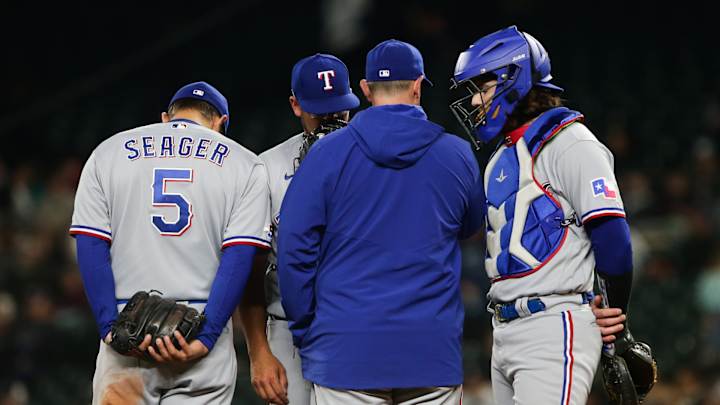Inside The Numbers: Breaking Down The Rangers' 2-9 Start

The Texas Rangers are off to an abysmal 2-9 start. However, the team is still confident that they are better than their record suggests.
"I don't want our team to get down," said Rangers pitcher Jon Gray after Tuesday night's loss in Seattle. "Things are going to get better for us. I know how good our team is. I'm not worried at all. I'm not worried one bit. We're really good. And that's going to show before too long."
If you take a look at the numbers, there are some signs that things will turn around for the Rangers soon. There are also some troubling signs that need fixed as soon as possible.
Some Bad Luck on Offense
The Rangers have been hitting a lot of hard outs. When you dig a little deeper, you'll see the club is tied for sixth in Major League Baseball with an average exit velocity of 89.9 mph. That's just 1/10 behind the potent Toronto Blue Jays lineup and 0.5 mph behind the defending World Series champion Atlanta Braves.
Rangers batters have also hit the ball at least 95 mph 41.1 percent of the time (hard hit percentage). That is above average this season and well above average compared to last year's statistics.
In addition, the Rangers have an expected batting average of .259 while their actual batting average is 24 points lower at .235. Meanwhile, teams off to an 8-4 start like the Colorado Rockies have an expected batting average that is lower than the real thing.
Why do these numbers matter? Because in the small sample size of 11 games, teams can be unlucky like the Rangers are right now. Over the course of a full 162-game season, the results are expected to be much better.
Marcus Semien
Corey Seager
Jonah Heim
Warning Signs
The pitching staff has really struggled in the first 11 games of the season. However, two different statistics are alarming.
First, the Rangers are having a difficult time with the No. 8 and 9 hitters in the opposing lineup. No. 8 hitters are are hitting .309 with a 1.099 OPS while No. 9 hitters are batting .390 with a 1.004 OPS.
This is a recipe for disaster. Modern baseball lineups are built with the best hitters near the top of the lineup. For example, the Los Angeles Angels had Shohei Ohtani and Mike Trout bat first and second in all four games against the Rangers last week. If the other team is turning over the lineup to hitters like that with runners on base, it's just asking for them to put up runs.
Second, the first and fifth innings are where opponents are doing the most damage against the pitching staff. Of the 69 runs allowed by the Rangers thus far, 28 have scored in these two innings (14 in each).
The first inning is an obvious problem. It puts the team in an immediate hole. That's never good.
However, there are two different examples of where everything went wrong in the fifth inning.
In the first game of the season against the Blue Jays, John King started his outing in the fifth inning. He did what he should have done against the No. 8 and 9 hitters to start the frame—got both of them out. However, he walked George Springer then gave up a single to Bo Bichette. Josh Sborz relieved him, then allowed an RBI single and three-run home run to Teoscar Hernández. That capped a comeback by Toronto after the Rangers' lineup built a 7-0 lead.
On April 15 against the Angels, Kolby Allard got the No. 7 hitter out to lead off the fifth, but surrendered a home run to Kurt Suzuki in the 8-hole, then gave up a single to the No. 9 hitter. That flipped over the order to Ohtani, who clobbered a two-run homer. Mike Trout followed with a double then scored on an RBI single by Jared Walsh. The Rangers had a 6-2 lead heading into the frame.
Jon Gray
Dane Dunning talking with pitching coach Doug Mathis
John King
Final Thoughts
The Rangers have a pythagorean record of 4-7. If the Rangers didn't twice squander four-run leads in the fifth inning of games, they would likely be 4-7. That's still not a great record, but it's better than 2-9. It's also a better indication of how good (or bad) this team actually is.
Given the numbers laid out here, things should balance out for the Rangers if they can keep hitting the ball hard. There will be times where they get lucky. If the pitching staff can figure out how to keep the bottom-third of opposing lineups off the bases, this team might actually win the games they are supposed to win.
Statistics courtesy of Baseball Savant and Baseball-Reference.
